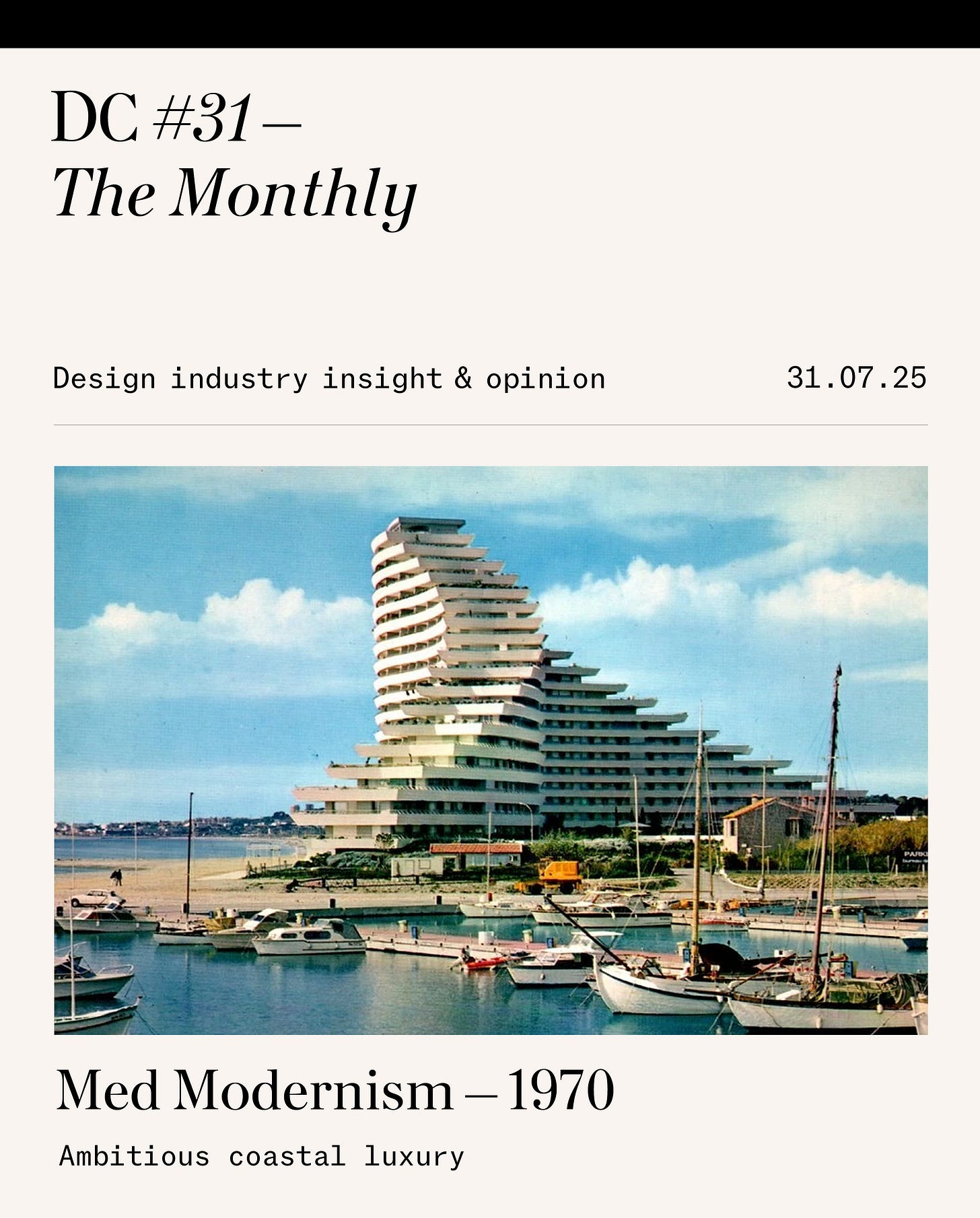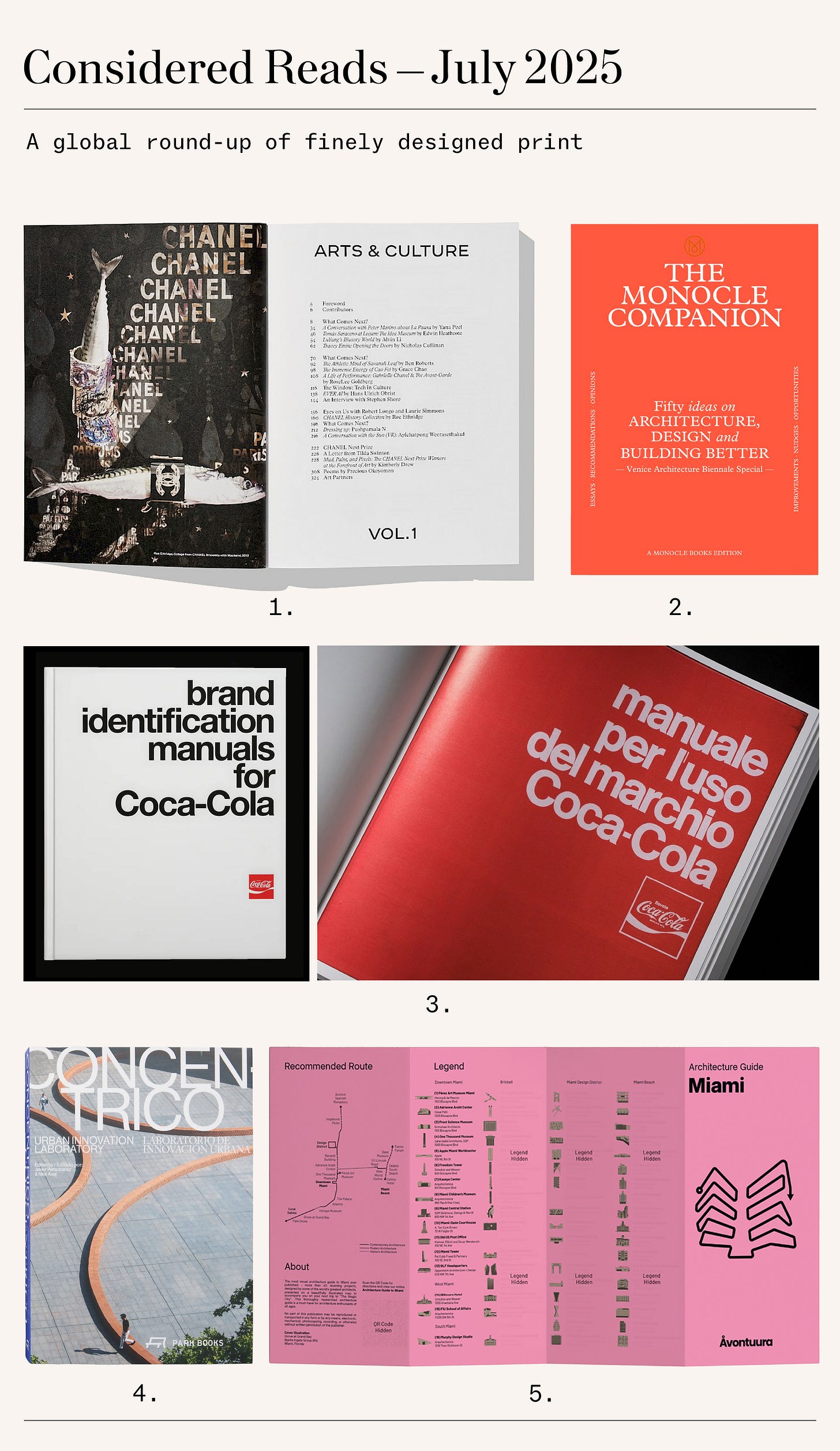Design Considered #31 – Monthly Edition
Future-proof job opportunities, modernism on the Med, and more...
#01 - Opening Thought
Zipping north along the glittering Côte d’Azur by train toward Cannes, the undulated form of the Marina Baie des Anges rising up in four monumental arcs is impossible to miss. Conceived in 1968 by architect André Minangoy (and not fully finished until 1993), this ambitious development embodied postwar optimism, une ville dans la ville, a self-contained town within a town, blending wide-balconied, socially attuned apartments with serene marina life. Open to the public, it was all sunny modernist thinking à la La Grande-Motte, France’s pyramidal prototype for a new era of leisure-driven urbanism. Smaller in scale and more desirable in location, Marina Baie des Anges, however, was a bit more on the premium side.
While today Marina Baie des Anges has lost some of its sheen, its approach to multi-res coastal luxury living offers a far more generous vision than what we’re now seeing in places like Miami or Marbella. Here, ‘branded residences’ promote a cold kind of privacy, operating in isolation from the cities and cultures they’re supposed to be a part of. If architecture reflects ambition, it’s worth asking what today’s most desirable coastal developments are aspiring to, and what they could be doing better.
#02 - Topiary Talent
As I type slowly and haphazardly into my word-processor and an AI tool whizzes through the text and spruces it up succinctly, I can almost feel the winds of change on my fingertips. This once-largely-human endeavour is becoming increasingly AI-enhanced. I think about what’s next, as new tech comes for laptop-based knowledge worker jobs, and I see opportunity in the great outdoors, a place I generally prefer to be anyway. While I imagine I may be genetically suited to farming (which my forefathers in England’s southwest practiced since the Norman invasion in 1066), I sadly feel this tight-margined type of business will also become an AI-run venture. Plus, it involves early mornings and hard, muddy labour...
I wonder if there’s a paid outdoor pursuit that’s a little more considered? Which is why I felt enamoured viewing images of the beautiful grand opening of Thom Browne’s boutique on Manhattan’s Upper East Side, where, among a sophisticated crowd, a topiary shaped like Browne’s iconic Hector dachshund bag had been carved into the surrounding hedges. Designed by the ever-clever Graphic Services NYC, the leafy 4ft sculpture greeted guests as both symbol and spectacle—an “ode to topiary”, perfectly in tune with its well-manicured surroundings.
People don’t talk enough about topiary. Mad, in this image-obsessed world—after all, who wouldn’t want to pose before a lovable, leafy canine?
Originating in ancient Rome, topiary was later embraced enthusiastically during the Renaissance, adorning grand gardens with whimsical geometric forms, animal shapes, and even mythical creatures. Its popularity surged again in the formal gardens of 17th-century France and England, where it became an aristocratic art form symbolising status and control over nature. By the mid-20th century, modernists like Belgian master Jacques Wirtz revitalised topiary, sculpting boxwoods and yews into abstract, minimalist forms that harmonised with contemporary architecture.
Unlike our 17th-century predecessors, we shouldn't be looking to control nature (climate change says we can’t anyway). However, as our city parks are (rightly) being allowed to grow more wild and meadow-like, perhaps a growing class of out-of-work creative practitioners could seek a meaningful career change sprucing up these green spaces’ outer hedges via tasteful topiary.
For further reading on the matter, I’d encourage you to explore:
Country Life – Topiary: The Ancient Art
Financial Times – On the Art of Topiary
And, if you’re in New York, make a pilgrimage to see the perfectly pruned Hector (more info on the real Hector here) located at Thom Browne, 72nd Street and Madison Avenue, Manhattan.
#03 - Design Selection
A tidy list of tomes for your summer kicks off with (1) Chanel’s Arts & Culture Vol.1, designed by the London-based graphic design office Zak Group and confirming the luxury brand’s continued commitment to print. Backed by Chanel’s influential Culture Fund, it's impeccably produced, smartly uniting fashion, contemporary art, and cultural dialogue through essays, visual portfolios, and interviews with luminaries like Refik Anadol, Tilda Swinton, and Tracey Emin.
Whether you’ve been to the Venice Architecture Biennale or you're planning to, (2) The Monocle Companion complements the event perfectly. It offers an insightful exploration of themes emerging from the Biennale via essays written by a bright cast of designers and design thinkers, lovingly illustrated by Jon Arne Berg, it also features a compelling photo essay by the talented Andrea Pugiotto. Also visually lush, (3) Brand Identification Manuals for Coca-Cola by Standards Manual collates Coca-Cola’s branding guidelines in inspiring fashion. The New York-based publisher should be celebrated for preserving classic graphic design manuals, highlighting the enduring power of precise visual guidelines.
(4) Concéntrico: Urban Innovation Laboratory, published by Park Books, captures the dynamic explorations of urbanism and temporary installations from Logroño’s annual Concéntrico Festival. Edited by the event’s founder Javier Peña Ibáñez, the volume thoughtfully showcases experimental designs that interrogate public space, sustainability, and community interaction through visually arresting photography and incisive essays. Finally, (5) Architecture Guide Miami by Åvontuura is a breezy companion mapping out the city's standout architectural highlights, all wrapped in a vibrant Miami-pink cover, capturing the city's spirited charm.







I recently finished perfection by Vincenzo Latronico (graphic designer-Berlin-nomad couple) and found it interesting the narrators talked about ‘becoming farmers’ as the antidote to their tech ridden myopia/depression… what will we lose when that bucolic ideal is corrupted by tech automation? Maybe it will become the ultimate luxury (we see this in brands like flamingo estate etc already I suppose). Great read!